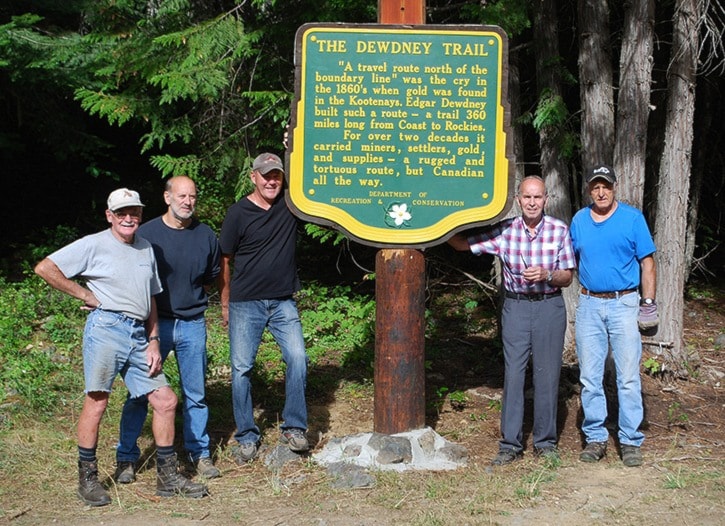People from all walks of life are joining forces to restore a local trail that’s older than the country itself.
Preserving, protecting and spurring the Dewdney Trail into its rightful place in Canadian prominence has long been a passion for Rossland’s Richie Mann and Graham Jones.
Now in its 150th year, the Dewdney Trail is in need of a 21st century over haul. So the two men recently gathered a whole new group of hikers, bikers, horsemen and historians to form the Dewdney Trail Heritage Society.
“We are feeling pretty good now that we sent off our forms and constitution to be registered as a society,” Mann told the Trail Times. “Things are coming together and we are feeling positive. And we are hoping to get the word province-wide, that is the goal.”
For decades the Trail Horseman’s Society and Boundary Stockhorse Association maintained the trail. Over time, due to members aging and other circumstances, the members haven’t been able to regularly travel through on foot and horse to ensure pathways are clear and in good shape.
Until about 10 years ago, the Dewdney Trail was used primarily by hikers and horseback riders so other than overgrown brush or fallen trees, the route remained quite pristine.
But modern sport on two wheels has caused damage mainly to the steeper terrain, and areas that are deeply grooved require more than muscle – remediation entails the purchase of materials such as aggregates.
Jones said the Ministry of Forests has been helpful to singular voices, but prefers to deal with an association that works together in harmony.
“Bringing all these people together with different backgrounds, knowledge and experience we get this collaboration of abilities and enthusiasm to get this done,” said Jones. “This is how we can have our input with support, materials, and whatever those aspects might be.”
As the group awaits the official stamp of recognition as a heritage society, a work party is scheduled for next week.
The dry summer conditions halted brush clearing until now, says Mann.
“We didn’t want to get our power saws going out there, and forestry did give us the heads up on that,” explained the lifelong back country horseman. “Now that we’ve had some rain we will be going out the first week of August.”
The hot spell didn’t keep the group sitting idle however.
After receiving funding through Linda Worley, regional director for Area B, an out-of-commission sign was pulled from storage and restored by Jones. Volunteers gathered last week to remount the eye-catching piece at the Dewdney Trail head on Highway 22 in Paterson.
“Thanks so much to all the volunteers, without whom, these monumental moments in our Area B history could not be possible,” said Worley.
“The Dewdney Trail, its significance and contributions to our past, is immeasurable. Throughout the last century and a half, its existence has provided the ability to access these incredible lands,” she added.
“We are privileged to inhabit and entrusted us with its upkeep and wellbeing.”
For information on the Dewdney Trail restoration project, contact Mann at 362.9465 or by email at richiemann11@gmail.com. Jones can be reached at 362.9966 or at jumbuck65@yahoo.ca.
Another key member of the initiative is local historian Sam McBride, a descendent of Edgar Dewdney, the gentleman who began carving out the trail in 1860. Dewdney was said to be a giant (6’4”) in stature compared to others of his time. He was a hardy young surveyor, originally from Wales, when Colonial Governor Fredrick Seymour of Victoria hired him to continue the monumental feat.
The 1865 mission was to construct a pathway for man and horse through the West Kootenay to Wild Horse Creek in the east.
The pack trail served two purposes. It provided a Canadian presence in the region known to be rich in gold, and it gave prospectors a leg up on the Americans who tried to slip into the region through Washington territory and grab the precious cargo before heading back over the line.
“Without the trail we could have had a whole different landscape,” said McBride.
“We may not be in the same country if it were not for the Dewdney Trail,” he explained, mentioning the United States purchased Alaska and taking over B.C. would have provided a connection between the south and north land mass.
“So the Dewdney Trail was a statement of sovereignty for Britain and later Canada,” he said. “And (gave) protection against American encroachment.”
Described as a rugged and torturous route, but Canadian all the way, the Dewdney Trail runs about 720 kilometres from Fort Hope on the Fraser River through to present day Hope, Grand Forks, Christina Lake, and Rossland. The trail then carries east through the Pend d’Oreille and Creston, to Cranbrook’s Wild Horse Creek (Fort Steele).
The original local trail begins near Grand Forks and follows through the mountainous region approximately 39 kilometres east to Paterson.
